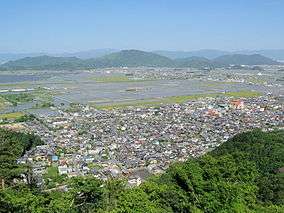Ōmihachiman
| Ōmihachiman 近江八幡市 | |||
|---|---|---|---|
| City | |||
 Old city view from Mt. Hachiman | |||
| |||
 Location of Ōmihachiman in Shiga Prefecture | |||
 Ōmihachiman Location in Japan | |||
| Coordinates: 35°07′42″N 136°5′53″E / 35.12833°N 136.09806°ECoordinates: 35°07′42″N 136°5′53″E / 35.12833°N 136.09806°E | |||
| Country | Japan | ||
| Region | Kansai | ||
| Prefecture | Shiga Prefecture | ||
| Government | |||
| • Mayor | Osamu Konishi <小西 理> (from April 2018) | ||
| Area | |||
| • Total | 177.45 km2 (68.51 sq mi) | ||
| Population (1 April, 2018) | |||
| • Total | 82,116 | ||
| • Density | 462.76/km2 (1,198.5/sq mi) | ||
| Symbols | |||
| • Tree | Azalea, Sakura | ||
| • Flower | Salvia | ||
| Time zone | UTC+9 (JST) | ||
| City hall address |
236 Sakuragi-chō, Ōmihachiman-shi, Shiga-ken 523-8501 | ||
| Website |
www | ||
Ōmihachiman (近江八幡市 Ōmihachiman-shi) is a city located in Shiga Prefecture, Japan.
The city was founded on March 31, 1954. In the quinquennial census of 2010, it has a population of 81,730 (2005: 80,610)[1] and a population density of 1,062 persons per km². The total area is 76.97 km².
On March 21, 2010, the town of Azuchi (from Gamō District) was merged into Ōmihachiman.
Naming
"Ōmihachiman" means "Hachiman in Ōmi". When Hachiman Town (the forerunner of this city) became a city, there was the existing city of Yahata in Fukuoka Prefecture. In Japanese, "Hachiman" and "Yahata" are written by same kanji, so "Ōmi" was added to avoid being confused. "Hachiman" is the Shinto god of war. His symbol is the dove.
History
Ōmihachiman had been a developed commercial town even since Toyotomi Hidetsugu built a castle and gathered many merchants in the last part of 16th century. Former merchant's residences and a canal used for transport are preserved in an old city area, designated a Preservation District for Groups of Traditional Buildings[2] and an Important Cultural Landscape.[3]
In 1905, an American architect William Merrell Vories came to Ōmihachiman as an English language teacher at commercial high school. Two years later he resigned the original work, but he remained in Ōmihachiman and spent most of his productive life here. He handed down western-style buildings, a pharmaceutical company, an educational foundation and a hospital to the city.
Education
International schools:
- Colégio Latino do Japão - Brazilian school[4]
Sister cities
Within Japan
Outside Japan
- Grand Rapids, Michigan, USA
- Leavenworth, Kansas, USA
- Miryang, Gyeongsangnam-do, South Korea
- Mantua, Lombardy, Italy
Places of interest
- Himure Hachimangū - The largest shrine in Ōmihachiman which was the name origin of the city name "Hachiman".
- Sagichō Festival - A fire festival in every March which is held in the old city area and the Himure Hachimangū.
- Mount Hachiman or Mount Kakuyoku - A mountain which there was Hidetsugu's castle. Hachimanyama Ropeway services between the mountaintop and Himure Hachimangū.
- Hachiman-bori canal
- Suigō meguri - In the northeast of the city central, sightseeing boats service through the rural lagoon.
- Kawara Museum
- Lake Biwa
- Okishima Island - A fishing island which is the only inhabited lake island in Japan.
- Isaki no Sao-tobi - A water festival in every August which tests men's courage to jump into the lake from the Isaki Temple.
- Musa-juku
References
- ↑ "2010 census". Ministry of Internal Affairs and Communications. Retrieved 29 April 2011.
- ↑ "Database of Registered National Cultural Properties". Agency for Cultural Affairs. Retrieved 6 September 2011.
- ↑ "Database of Registered National Cultural Properties". Agency for Cultural Affairs. Retrieved 29 April 2011.
- ↑ "Escolas Brasileiras Homologadas no Japão" (Archive). Embassy of Brazil in Tokyo. Retrieved on October 13, 2015.
External links
| Wikimedia Commons has media related to Omihachiman, Shiga. |
- Ōmihachiman City official website (in Japanese)
- Ōmihachiman Tourism Association (in Japanese)

